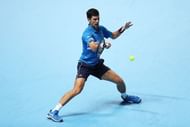England's World Cup-winning cricket captain Eoin Morgan recently opined that T10 is cricket's best bet yet to get to the Olympics in a talk show ahead of the Abu Dhabi T10 league, season 3. While tennis has nothing to worry about in this regard, there is an increasing need for ways to shorten the game or for shorter versions.
Scotland's Mark Milne, the founder of a new tennis format he looks to make global called Thirty30, realized this need earlier than most as he set the wheels in motion for his innovation. He sensed the shift in how the younger generations view the sport, especially how long they enjoy a contest. Even Novak Djokovic felt that there's a need for a shorter, more dynamic format last year, adding that the millennial and younger tennis fans don't have great attention spans. You will realize that the ITF too has these issues in mind if you look at the updated Rules of Tennis.
Evolving rules

There is a new Appendix Appendix V which is for alternative methods to shorten matches. In fact, the Tokyo 2020 Olympics will for the first time, feature just 3-set men's singles final in tennis and deciding match tie-break (10 points) at 1 set all in the doubles events.
Apart from this there is already a shorter format, Fast4, which has changes like first to 4 games sets, deciding point at deuce and no Let calls. This 5-set format with the tie-break at 3-3 was trialled in the ATP Next Gen tournaments in 2017 & 2018 before being used again this year (with Lets). While this seems a good way to go, the traditional aspects of tennis like the ads at 40-40 and the 6-game sets are done away with.
In Cricket the 60-ball format didn't please the purists of the game, mainly citing that the batsmen didn't have to worry too much about getting out and hence the balance was affected. Earlier this year the English Cricket board introduced The Hundred, a middle-ground between T10 & T20 (Twenty20). 100 balls to each team, split either as 5-ball or 10-ball overs, the fielding team decides.
This is slightly similar to what Mark aims to do in tennis with the introduction of his Thirty30 (T30) format. In both these new initiatives for their respective sports, the name gives a fair idea about the format.
Crisper action
In Thirty30, as it's called, each game starts at 30-30 but nearly all other aspects of traditional tennis are retained. The few additional changes are mainly in the margin or length of the tie-breakers and the change of ends. The tie-break will be a 9-point affair with a sudden death point at 4-4, so the margin could range from 5-0 to 5-4. This tie-break rule is already included in appendix V.
Change of ends will initially occur after the first two games and then after every four games during a set. The usual procedure is initially after the first game and then after every and two games. There will be no match tie-breaks and it seems like a fair move. At a set each the 3rd set 10-point tie-break to decide the winner is not exactly a true reflection of performance. There is also no tie-break in the final sets in the T30 format. This enables the match to ebb and flow like how tennis usually does while the decrease in number of change of ends and of course 30-30 game starts speeding things up.
The format brìngs the balance that could be closer to appeasing the critics of the Fast4 system and the 10-point match tie-break. Thirty30 has three variants of tennis, the one-setter and best of three & best of five set encounters. There is, in fact, enough variety within this new format that it could exist as a separate tennis tour. Although a middle ground, The Hundred in cricket is a running controversy even though the first season will be played next year.
Similarly, there would be some tough questions asked on the exciting Thirty30 for sure, but traditional sports inevitably have to push for shorter versions to stay relevant and popular, with the world existing in a faster plane. The fact that this format still retains most aspects of tennis as we know it, makes sure the identity isn't lost in the name of innovations.
For further information, click here.
How did Novak Djokovic meet Jelena Ristic? All about the most admired couples in tennis
